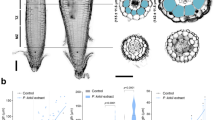Abstract
MEMBERS of the family Orobanchaceae are root parasites attached underground to suitable hosts. In some cases attachment is effected by special mechanisms of the parasite. For example, the mature seed of Orobanche, stimulated chemotropically by diffusion of compounds from the host, germinates and its extending radicle establishes contact with the host1,2. We report here a previously unknown mechanism in Boschniakia hookeri, a perennial parasite found only on the roots of certain members of the Ericaceae in a narrow westerly distribution on the North American continent. We found that the connection of the parasite to the host is due ultimately to the behaviour of the host root, which grows through the testa of the parasite's seed into contact with the embryo.
This is a preview of subscription content, access via your institution
Access options
Subscribe to this journal
Receive 51 print issues and online access
$199.00 per year
only $3.90 per issue
Buy this article
- Purchase on Springer Link
- Instant access to full article PDF
Prices may be subject to local taxes which are calculated during checkout
Similar content being viewed by others
References
Vaucher, J. P. Mém. Mus. Hist. nat. Paris 10, 261–273 (1823).
Kuijt, J. The Biology of Parasitic Flowering Plants (University of California Press, Berkeley and Los Angeles, 1969).
Tiagi, B. Bot. Notiser 116, 81–93 (1963).
Author information
Authors and Affiliations
Rights and permissions
About this article
Cite this article
OLSEN, S., OLSEN, I. Growth of host root establishes contact with parasitic angiosperm Boschniakia hookeri. Nature 279, 635–636 (1979). https://doi.org/10.1038/279635a0
Received:
Accepted:
Issue Date:
DOI: https://doi.org/10.1038/279635a0
This article is cited by
Comments
By submitting a comment you agree to abide by our Terms and Community Guidelines. If you find something abusive or that does not comply with our terms or guidelines please flag it as inappropriate.



